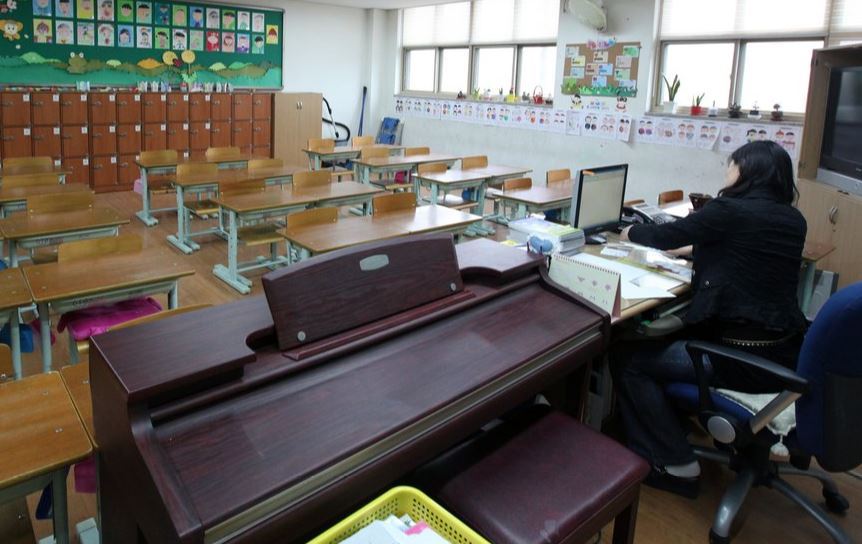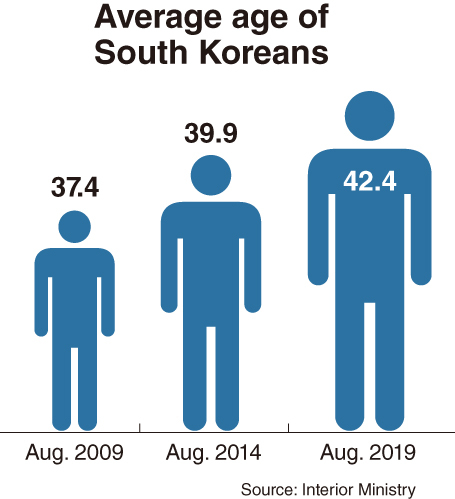[News Focus] Koreans 5 years older, on average, than a decade ago
By Kim Yon-sePublished : Sept. 8, 2019 - 16:21
SEJONG -- South Korea has become one of several countries undergoing rapid demographic changes that could dent the nation’s competitiveness in the mid- to long term.
With fewer babies being born, senior citizens make up a growing proportion of the Korean population and the average age has climbed over the past decade.
According to the Ministry of Interior and Safety, the average age reached 42.4 years as of August, as compared with 41.9 a year earlier.
The average ages for men and women were 41.3 and 43.6, respectively, across the country.
In South Jeolla Province, the average age was highest at 46 (44.1 for men and 47.9 for women). North Gyeongsang Province ranked second at 45.4, followed by Gangwon Province at 45.1, North Jeolla Province at 44.7, Busan (Korea’s second-largest city) at 44.3 and South Chungcheong Province at 43.4.
With fewer babies being born, senior citizens make up a growing proportion of the Korean population and the average age has climbed over the past decade.
According to the Ministry of Interior and Safety, the average age reached 42.4 years as of August, as compared with 41.9 a year earlier.
The average ages for men and women were 41.3 and 43.6, respectively, across the country.
In South Jeolla Province, the average age was highest at 46 (44.1 for men and 47.9 for women). North Gyeongsang Province ranked second at 45.4, followed by Gangwon Province at 45.1, North Jeolla Province at 44.7, Busan (Korea’s second-largest city) at 44.3 and South Chungcheong Province at 43.4.

The average age exceeded 40 in 16 of the 17 major cities and provinces, with Sejong being the sole exception with an average age of 36.8. Seoul recorded 42.5 (41.6 for men and 43.3 for women).
Compared with the nationwide average of 37.4 in August 2009, the country had aged five years to 42.4 on the whole a decade later. The average age reached 40.0 in October 2014 for the first time in history.
Moreover, comparisons of the percentage of older and younger people against the population as a whole reveal worrisome changes to the nation’s demographic structure.
The proportion of Koreans aged between zero and 14 stood at 12.6 percent as of August 2019 -- a sharp contrast to the 16.8 percent posted 10 years earlier.
In contrast, those aged 65 or over made up 15.2 percent of the total, up 5 percentage points from 10.5 percent a decade ago.
The same trend is evident from comparisons of population growth in different age brackets -- the population decreased from 8.33 million to 6.51 million for the group aged zero to 14, but increased from 5.2 million to 7.89 million for those aged 65 or above.
As the number and proportion of senior citizens increased, the working-age population -- those aged between 15 and 64 -- fell from 72.7 percent to 72.2 percent of the total over the past decade.
According to the Interior Ministry data, Korea’s working-age population peaked at 37.78 million in November 2016.
The figure has dropped consistently since December 2016. As of August 2019 it stood at 37.43 million, having declined for the 33rd consecutive month. That amounts to 350,000 fewer people in less than three years.
In addition, last month’s figure marked the lowest in five years, since August 2013, when the number of people aged 15-64 posted 37.41 million.

In other words, the working-age population is shrinking in proportion to the population as a whole.
A government official said the drop in recent years is critical as the baby boomer generation, born between 1955 and 1963, still belongs to the working-age population.
He predicted a steeper decline in the working-age population beginning in 2020, when people born in 1955 become senior citizens.
A research fellow from the LG Economic Research Institute predicted that the shrinking workforce would “slash the nation’s GDP growth by 0.4 percentage point between 2020 and 2024, and by 0.5 percentage point between 2025 and 2029.”
There is another risk factor, according to analysts. Those born between 1968 and 1974, known in Korea as “the second generation of baby boomers,” are currently in their mid-40s to early 50s.
As this generation ages in the coming decade, the percentage of Koreans in their 40s, considered the backbone of the nation’s industries, will fall drastically.
Statistics Korea forecast that the proportion of people aged 65 or over would break the 20 percent mark by 2025 and 30 percent by 2036.
By Kim Yon-se (kys@heraldcorp.com)








![[Kim Seong-kon] Democracy and the future of South Korea](http://res.heraldm.com/phpwas/restmb_idxmake.php?idx=644&simg=/content/image/2024/04/16/20240416050802_0.jpg&u=)







![[KH Explains] Hyundai's full hybrid edge to pay off amid slow transition to pure EVs](http://res.heraldm.com/phpwas/restmb_idxmake.php?idx=652&simg=/content/image/2024/04/18/20240418050645_0.jpg&u=20240418181020)

![[Today’s K-pop] Zico drops snippet of collaboration with Jennie](http://res.heraldm.com/phpwas/restmb_idxmake.php?idx=642&simg=/content/image/2024/04/18/20240418050702_0.jpg&u=)